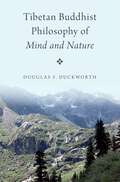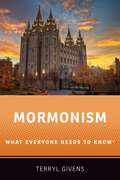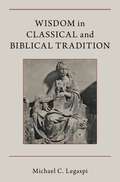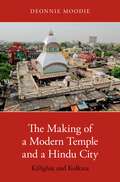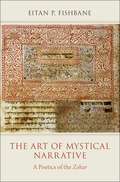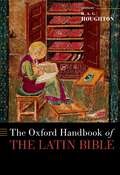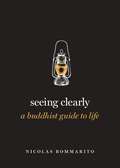- Table View
- List View
Tibetan Buddhist Philosophy of Mind and Nature
by Douglas S. DuckworthTibetan Buddhist Philosophy of Mind and Nature offers an engaging philosophical overview of Tibetan Buddhist thought. Integrating competing and complementary perspectives on the nature of mind and reality, Douglas Duckworth reveals the way that Buddhist theory informs Buddhist practice in various Tibetan traditions. Duckworth draws upon a contrast between phenomenology and ontology to highlight distinct starting points of inquiries into mind and nature in Buddhism, and to illuminate central issues confronted in Tibetan Buddhist philosophy. This thematic study engages some of the most difficult and critical topics in Buddhist thought, such as the nature of mind and the meaning of emptiness, across a wide range of philosophical traditions, including the "Middle Way" of Madhyamaka, Yogacara (also known as "Mind-Only"), and tantra. Duckworth provides a richly textured overview that explores the intersecting nature of mind, language, and world depicted in Tibetan Buddhist traditions. Further, this book puts Tibetan philosophy into conversation with texts and traditions from India, Europe, and America, exemplifying the possibility and potential for a transformative conversation in global philosophy.
Tibetan Buddhist Philosophy of Mind and Nature
by Douglas S. DuckworthTibetan Buddhist Philosophy of Mind and Nature offers an engaging philosophical overview of Tibetan Buddhist thought. Integrating competing and complementary perspectives on the nature of mind and reality, Douglas Duckworth reveals the way that Buddhist theory informs Buddhist practice in various Tibetan traditions. Duckworth draws upon a contrast between phenomenology and ontology to highlight distinct starting points of inquiries into mind and nature in Buddhism, and to illuminate central issues confronted in Tibetan Buddhist philosophy. This thematic study engages some of the most difficult and critical topics in Buddhist thought, such as the nature of mind and the meaning of emptiness, across a wide range of philosophical traditions, including the "Middle Way" of Madhyamaka, Yogacara (also known as "Mind-Only"), and tantra. Duckworth provides a richly textured overview that explores the intersecting nature of mind, language, and world depicted in Tibetan Buddhist traditions. Further, this book puts Tibetan philosophy into conversation with texts and traditions from India, Europe, and America, exemplifying the possibility and potential for a transformative conversation in global philosophy.
Tongues of Fire: Language and Evangelization in Colonial Mexico
by Nancy FarrissIn Tongues of Fire, Nancy Farriss investigates the role of language and translation in the creation of Mexican Christianity during the first centuries of colonial rule. Spanish missionaries collaborated with indigenous intellectuals to communicate the gospel in dozens of unfamiliar local languages that had previously lacked grammars, dictionaries, or alphabetic script. The major challenge to translators, more serious than the absence of written aids or the great diversity of languages and their phonetic and syntactical complexity, was the vast cultural difference between the two worlds. The lexical gaps that frustrated the search for equivalence in conveying fundamental Christian doctrines derived from cultural gaps that separated European experiences and concepts from those of the Indians. Farriss shows that the dialogue arising from these efforts produced a new, culturally hybrid form of Christianity that had become firmly established by the end of the 17th century. The study focuses on the Otomangue languages of Oaxaca in southern Mexico, especially Zapotec, and relates their role within the Dominican program of evangelization to the larger context of cultural contact in post-conquest Mesoamerica. Fine-grained analysis of translated texts reveals the rhetorical strategies of missionary discourse. Spotlighting the importance of the native elites in shaping what emerged as a new form of Christianity, Farriss shows how their participation as translators and parish administrators helped to make evangelization an indigenous enterprise, and the new Mexican church an indigenous one.
Tongues of Fire: Language and Evangelization in Colonial Mexico
by Nancy FarrissIn Tongues of Fire, Nancy Farriss investigates the role of language and translation in the creation of Mexican Christianity during the first centuries of colonial rule. Spanish missionaries collaborated with indigenous intellectuals to communicate the gospel in dozens of unfamiliar local languages that had previously lacked grammars, dictionaries, or alphabetic script. The major challenge to translators, more serious than the absence of written aids or the great diversity of languages and their phonetic and syntactical complexity, was the vast cultural difference between the two worlds. The lexical gaps that frustrated the search for equivalence in conveying fundamental Christian doctrines derived from cultural gaps that separated European experiences and concepts from those of the Indians. Farriss shows that the dialogue arising from these efforts produced a new, culturally hybrid form of Christianity that had become firmly established by the end of the 17th century. The study focuses on the Otomangue languages of Oaxaca in southern Mexico, especially Zapotec, and relates their role within the Dominican program of evangelization to the larger context of cultural contact in post-conquest Mesoamerica. Fine-grained analysis of translated texts reveals the rhetorical strategies of missionary discourse. Spotlighting the importance of the native elites in shaping what emerged as a new form of Christianity, Farriss shows how their participation as translators and parish administrators helped to make evangelization an indigenous enterprise, and the new Mexican church an indigenous one.
Mormonism: What Everyone Needs to Know® (What Everyone Needs To KnowRG)
by Terryl GivensMormonism, or the Church of Jesus Christ of Latter-day Saints, is America's most successful-and most misunderstood-home grown religion. The church today boasts more than 15 million members worldwide, a remarkable feat in the face of increasing secularity. The growing presence of Mormonism shows no signs of abating, as the makeup of its membership becomes progressively diverse. The heightened contemporary relevance and increasingly global membership of the Church solidifies Mormonism as a religious group much deserving of awareness. Covering the origins, history, and modern challenges of the church, Mormonism: What Everyone Needs to Know offers readers a brief, authoritative guide to one of the fastest growing faith groups of the twenty-first century in a reader-friendly format, providing answers to questions such as: What circumstances gave rise to the birth of Mormonism? Why was Utah chosen as a place of refuge? Do you have to believe the Book of Mormon to be a Latter-day Saint? Why do women not hold the priesthood? How wealthy is the church and how much are top leaders paid? Written by a believer and the premier scholar of the Latter-day Saints faith, this remarkably readable introduction provides a sympathetic but unstinting account of one of the few religious traditions to maintain its vitality and growth in an era of widespread disaffiliation.
MORMONISM WENK C: What Everyone Needs to Know® (What Everyone Needs To KnowRG)
by Terryl GivensMormonism, or the Church of Jesus Christ of Latter-day Saints, is America's most successful-and most misunderstood-home grown religion. The church today boasts more than 15 million members worldwide, a remarkable feat in the face of increasing secularity. The growing presence of Mormonism shows no signs of abating, as the makeup of its membership becomes progressively diverse. The heightened contemporary relevance and increasingly global membership of the Church solidifies Mormonism as a religious group much deserving of awareness. Covering the origins, history, and modern challenges of the church, Mormonism: What Everyone Needs to Know offers readers a brief, authoritative guide to one of the fastest growing faith groups of the twenty-first century in a reader-friendly format, providing answers to questions such as: What circumstances gave rise to the birth of Mormonism? Why was Utah chosen as a place of refuge? Do you have to believe the Book of Mormon to be a Latter-day Saint? Why do women not hold the priesthood? How wealthy is the church and how much are top leaders paid? Written by a believer and the premier scholar of the Latter-day Saints faith, this remarkably readable introduction provides a sympathetic but unstinting account of one of the few religious traditions to maintain its vitality and growth in an era of widespread disaffiliation.
Wisdom in Classical and Biblical Tradition
by Michael C. LegaspiWisdom in Classical and Biblical Tradition begins with the recognition that modern culture emerged from a synthesis of the legacies of ancient Greek civilization and the theological perspectives of the Jewish and Christian scriptures. Part of what made this synthesis possible was a shared outlook: a common aspiration toward wholeness of understanding that refused to separate knowledge from goodness, virtue from happiness, cosmos from polis, and divine authority from human responsibility. This wholeness of understanding, or wisdom, featured prominently in both classical and biblical literatures as an ultimate good. Michael Legaspi has two central aims. The first is to explain in formal terms what wisdom is. Though wisdom involves matters of practical judgment affecting the life of the individual and the community, it has also been identified with an understanding of the world and of the ultimate realities that give meaning to human thought and action. In its traditional form, wisdom was understood to govern intellectual, social, and ethical endeavors. His second aim is to analyze figures and texts that have yielded and shaped the traditional understanding of wisdom. The book examines accounts of wisdom within foundational texts that range from the period of Homer to the destruction of the Second Temple. In doing so, it explains why the search for wisdom remains an important but problematic endeavor today.
Wisdom in Classical and Biblical Tradition
by Michael C. LegaspiWisdom in Classical and Biblical Tradition begins with the recognition that modern culture emerged from a synthesis of the legacies of ancient Greek civilization and the theological perspectives of the Jewish and Christian scriptures. Part of what made this synthesis possible was a shared outlook: a common aspiration toward wholeness of understanding that refused to separate knowledge from goodness, virtue from happiness, cosmos from polis, and divine authority from human responsibility. This wholeness of understanding, or wisdom, featured prominently in both classical and biblical literatures as an ultimate good. Michael Legaspi has two central aims. The first is to explain in formal terms what wisdom is. Though wisdom involves matters of practical judgment affecting the life of the individual and the community, it has also been identified with an understanding of the world and of the ultimate realities that give meaning to human thought and action. In its traditional form, wisdom was understood to govern intellectual, social, and ethical endeavors. His second aim is to analyze figures and texts that have yielded and shaped the traditional understanding of wisdom. The book examines accounts of wisdom within foundational texts that range from the period of Homer to the destruction of the Second Temple. In doing so, it explains why the search for wisdom remains an important but problematic endeavor today.
The Insurmountable Darkness of Love: Mysticism, Loss, and the Common Life
by Douglas E. ChristieThe primary aim of this book is to reconsider the meaning of darkness within mystical and contemplative thought and practice--especially as the ground and source of love. The book examines how a sustained, critical attention to apophatic spiritual traditions can help us respond to the gaps, silences, and empty places that have become such a prominent feature of contemporary experience. Contemplative practice rooted in unknowing reflects a deep respect for the unsayable, but also comes to expression in a rich and varied poetry of darkness that limns loss and absence with great delicacy, grace and courage. This book considers how critical retrieval of this poetry--especially that arising from ancient Christian traditions of the via negativa--can help us engage and respond to our own experiences of loss and absence. It argues that our experience of contemplative spiritual practice can be revitalized by attending more carefully to the darkness that so often surrounds and courses through it, not only as part of personal practice but also as part of the shared work of recovering and deepening what the Christian mystical tradition often refers to simply as "the common life." Or what the thirteenth-century Flemish mystic Hadewijch of Antwerp calls "the insurmountable darkness of love."
The Insurmountable Darkness of Love: Mysticism, Loss, and the Common Life
by Douglas E. ChristieThe primary aim of this book is to reconsider the meaning of darkness within mystical and contemplative thought and practice--especially as the ground and source of love. The book examines how a sustained, critical attention to apophatic spiritual traditions can help us respond to the gaps, silences, and empty places that have become such a prominent feature of contemporary experience. Contemplative practice rooted in unknowing reflects a deep respect for the unsayable, but also comes to expression in a rich and varied poetry of darkness that limns loss and absence with great delicacy, grace and courage. This book considers how critical retrieval of this poetry--especially that arising from ancient Christian traditions of the via negativa--can help us engage and respond to our own experiences of loss and absence. It argues that our experience of contemplative spiritual practice can be revitalized by attending more carefully to the darkness that so often surrounds and courses through it, not only as part of personal practice but also as part of the shared work of recovering and deepening what the Christian mystical tradition often refers to simply as "the common life." Or what the thirteenth-century Flemish mystic Hadewijch of Antwerp calls "the insurmountable darkness of love."
The Next Mormons: How Millennials Are Changing the LDS Church
by Jana RiessAmerican Millennials--the generation born in the 1980s and 1990s--have been leaving organized religion in unprecedented numbers. For a long time, the Church of Jesus Christ of Latter-day Saints was an exception: nearly three-quarters of people who grew up Mormon stayed that way into adulthood. In The Next Mormons, Jana Riess demonstrates that things are starting to change. Drawing on a large-scale national study of four generations of current and former Mormons as well as dozens of in-depth personal interviews, Riess explores the religious beliefs and behaviors of young adult Mormons, finding that while their levels of belief remain strong, their institutional loyalties are less certain than their parents' and grandparents'. For a growing number of Millennials, the tensions between the Church's conservative ideals and their generation's commitment to individualism and pluralism prove too high, causing them to leave the faith-often experiencing deep personal anguish in the process. Those who remain within the fold are attempting to carefully balance the Church's strong emphasis on the traditional family with their generation's more inclusive definition that celebrates same-sex couples and women's equality. Mormon families are changing too. More Mormons are remaining single, parents are having fewer children, and more women are working outside the home than a generation ago. The Next Mormons offers a portrait of a generation navigating between traditional religion and a rapidly changing culture.
The Next Mormons: How Millennials Are Changing the LDS Church
by Jana RiessAmerican Millennials--the generation born in the 1980s and 1990s--have been leaving organized religion in unprecedented numbers. For a long time, the Church of Jesus Christ of Latter-day Saints was an exception: nearly three-quarters of people who grew up Mormon stayed that way into adulthood. In The Next Mormons, Jana Riess demonstrates that things are starting to change. Drawing on a large-scale national study of four generations of current and former Mormons as well as dozens of in-depth personal interviews, Riess explores the religious beliefs and behaviors of young adult Mormons, finding that while their levels of belief remain strong, their institutional loyalties are less certain than their parents' and grandparents'. For a growing number of Millennials, the tensions between the Church's conservative ideals and their generation's commitment to individualism and pluralism prove too high, causing them to leave the faith-often experiencing deep personal anguish in the process. Those who remain within the fold are attempting to carefully balance the Church's strong emphasis on the traditional family with their generation's more inclusive definition that celebrates same-sex couples and women's equality. Mormon families are changing too. More Mormons are remaining single, parents are having fewer children, and more women are working outside the home than a generation ago. The Next Mormons offers a portrait of a generation navigating between traditional religion and a rapidly changing culture.
The Making of a Modern Temple and a Hindu City: Kalighat and Kolkata
by Deonnie MoodieKalighat is said to be the oldest and most potent Hindu pilgrimage site in the city of Kolkata (formerly Calcutta). It is home to the dark goddess Kali in her ferocious form and attracts thousands of worshipers a day, many sacrificing goats at her feet. In The Making of a Modern Temple and a Hindu City, Deonnie Moodie examines the ways middle-class authors, judges, and activists have worked to modernize Kalighat over the past long century. Rather than being rejected or becoming obsolete with the arrival of British colonialism and its accompanying iconoclastic Protestant ideals, the temple became a medium through which middle-class Hindus could produce and publicize their modernity, as well as the modernity of their city and nation. That trend continued and even strengthened in the wake of India's economic liberalization in the 1990s. Kalighat is a superb example of the ways Hindus work to modernize India while also Indianizing modernity through Hinduism's material forms. Moodie explores both middle-class efforts to modernize Kalighat and the lower class's resistance to those efforts. Conflict between class groups throws into high relief the various roles the temple plays in peoples' lives, and explains why the modernizers have struggled to bring their plans to fruition. The Making of a Modern Temple and a Hindu City is the first scholarly work to juxtapose and analyze processes of historiographical, institutional, and physical modernization of a Hindu temple.
The Making of a Modern Temple and a Hindu City: Kalighat and Kolkata
by Deonnie MoodieKalighat is said to be the oldest and most potent Hindu pilgrimage site in the city of Kolkata (formerly Calcutta). It is home to the dark goddess Kali in her ferocious form and attracts thousands of worshipers a day, many sacrificing goats at her feet. In The Making of a Modern Temple and a Hindu City, Deonnie Moodie examines the ways middle-class authors, judges, and activists have worked to modernize Kalighat over the past long century. Rather than being rejected or becoming obsolete with the arrival of British colonialism and its accompanying iconoclastic Protestant ideals, the temple became a medium through which middle-class Hindus could produce and publicize their modernity, as well as the modernity of their city and nation. That trend continued and even strengthened in the wake of India's economic liberalization in the 1990s. Kalighat is a superb example of the ways Hindus work to modernize India while also Indianizing modernity through Hinduism's material forms. Moodie explores both middle-class efforts to modernize Kalighat and the lower class's resistance to those efforts. Conflict between class groups throws into high relief the various roles the temple plays in peoples' lives, and explains why the modernizers have struggled to bring their plans to fruition. The Making of a Modern Temple and a Hindu City is the first scholarly work to juxtapose and analyze processes of historiographical, institutional, and physical modernization of a Hindu temple.
The Art of Mystical Narrative: A Poetics of the Zohar
by Eitan P. FishbaneIn the study of Judaism, the Zohar has captivated the minds of interpreters for over seven centuries, and continues to entrance readers in contemporary times. Yet despite these centuries of study, very little attention has been devoted to the literary dimensions of the text, or to formal appreciation of its status as one of the great works of religious literature. The Art of Mystical Narrative offers a critical approach to the zoharic story, seeking to explore the interplay between fictional discourse and mystical exegesis. Eitan Fishbane argues that the narrative must be understood first and foremost as a work of the fictional imagination, a representation of a world and reality invented by the thirteenth-century authors of the text. He claims that the text functions as a kind of dramatic literature, one in which the power of revealing mystical secrets is demonstrated and performed for the reading audience. The Art of Mystical Narrative offers a fresh, interdisciplinary perspective on the Zohar and on the intersections of literary and religious studies.
The Oxford Handbook of the Latin Bible (OXFORD HANDBOOKS SERIES)
The Latin Bible stands at the heart of Western culture. For almost fifteen hundred years, it was the principal source for scholars, philosophers, and theologians to reflect on the ideas and narratives which shaped society in Europe and beyond. It continues to feature in Christian liturgy, music, and art, and has influenced both Latin and vernacular language and literature. Manuscripts of the Latin Bible showcase the artistic and technical achievements of Late Antiquity and the Middle Ages, and it was the first book to be produced with Gutenberg's printing press. Biblical interpretation played a central role in education, from sermons in antiquity to medieval schools and the development of the university. The Oxford Handbook of the Latin Bible contains thirty-one chapters covering the history of the Latin Bible from its earliest translations (the Vetus Latina), the revisions by Jerome and others leading to the Vulgate, the achievements and innovations of the Carolingian period and Middle Ages, the development of modern scholarship, and the twentieth-century innovation of the Nova Vulgata. It includes discussions of key figures and interpreters, the most important manuscripts, and the significance of the Latin Bible in multiple fields. The international team of contributors includes many of the world's leading authorities, along with representatives of a new generation of researchers developing new approaches and insights into this rich and diverse material. Each chapter introduces the current state of scholarship, with extensive references to key literature and electronic resources. This volume provides a unique overview of one of the world's most important books.
The Oxford Handbook of the Latin Bible (OXFORD HANDBOOKS SERIES)
by H. A. G. HoughtonThe Latin Bible stands at the heart of Western culture. For almost fifteen hundred years, it was the principal source for scholars, philosophers, and theologians to reflect on the ideas and narratives which shaped society in Europe and beyond. It continues to feature in Christian liturgy, music, and art, and has influenced both Latin and vernacular language and literature. Manuscripts of the Latin Bible showcase the artistic and technical achievements of Late Antiquity and the Middle Ages, and it was the first book to be produced with Gutenberg's printing press. Biblical interpretation played a central role in education, from sermons in antiquity to medieval schools and the development of the university. The Oxford Handbook of the Latin Bible contains thirty-one chapters covering the history of the Latin Bible from its earliest translations (the Vetus Latina), the revisions by Jerome and others leading to the Vulgate, the achievements and innovations of the Carolingian period and Middle Ages, the development of modern scholarship, and the twentieth-century innovation of the Nova Vulgata. It includes discussions of key figures and interpreters, the most important manuscripts, and the significance of the Latin Bible in multiple fields. The international team of contributors includes many of the world's leading authorities, along with representatives of a new generation of researchers developing new approaches and insights into this rich and diverse material. Each chapter introduces the current state of scholarship, with extensive references to key literature and electronic resources. This volume provides a unique overview of one of the world's most important books.
The Formation of Post-Classical Philosophy in Islam
by Frank GriffelScholars have come to recognize the importance of classical Islamic philosophy both in its own right and in its preservation of and engagement with Greek philosophical ideas. At the same time, the period immediately following the so-called classical era has been considered a sort of dark age, in which Islamic thought entered a long decline. In this monumental new work, Frank Griffel seeks to overturn this conventional wisdom, arguing that what he calls the "post-classical" period has been unjustly maligned and neglected by previous generations of scholars. The Formation of Post-Classical Philosophy in Islam is a comprehensive study of the far-reaching changes that led to a re-shaping of the philosophical discourse in Islam during the twelfth century. Earlier Western scholars thought that Islam's engagement with the tradition of Greek philosophy ended during that century. More recent analyses suggest that Islamic thinkers instead integrated Greek thought into the genre of rationalist Muslim theology (kal=am). Griffel argues that even this new view misses a key point. In addition to the integration of Greek ideas into kal=am, Muslim theologians picked up the discourse of classical philosophy in Islam (falsafa) and began to produce books in the tradition of Plato, Aristotle, and Avicennaa new and oft-misunderstood genre they called ".hikma"in which they left aside theological concerns. They wrote in both genres, kal=am and .hikma, and the same writers argued for opposing teachings on the nature of God, the world's creation, and the afterlife depending on the genre in which they were writing. Griffel shows how careful attention to genre demonstrates both the coherence and ambiguity of this new philosophical approach. A work of extraordinary breadth and depth, The Formation of Post-Classical Philosophy in Islam offers a detailed, insightful history of philosophy in Iraq, Iran, and Central Asia during the twelfth century. It will be essential reading for anyone interested in the history of philosophy or the history of Islam.
The Formation of Post-Classical Philosophy in Islam
by Frank GriffelScholars have come to recognize the importance of classical Islamic philosophy both in its own right and in its preservation of and engagement with Greek philosophical ideas. At the same time, the period immediately following the so-called classical era has been considered a sort of dark age, in which Islamic thought entered a long decline. In this monumental new work, Frank Griffel seeks to overturn this conventional wisdom, arguing that what he calls the "post-classical" period has been unjustly maligned and neglected by previous generations of scholars. The Formation of Post-Classical Philosophy in Islam is a comprehensive study of the far-reaching changes that led to a re-shaping of the philosophical discourse in Islam during the twelfth century. Earlier Western scholars thought that Islam's engagement with the tradition of Greek philosophy ended during that century. More recent analyses suggest that Islamic thinkers instead integrated Greek thought into the genre of rationalist Muslim theology (kal=am). Griffel argues that even this new view misses a key point. In addition to the integration of Greek ideas into kal=am, Muslim theologians picked up the discourse of classical philosophy in Islam (falsafa) and began to produce books in the tradition of Plato, Aristotle, and Avicennaa new and oft-misunderstood genre they called ".hikma"in which they left aside theological concerns. They wrote in both genres, kal=am and .hikma, and the same writers argued for opposing teachings on the nature of God, the world's creation, and the afterlife depending on the genre in which they were writing. Griffel shows how careful attention to genre demonstrates both the coherence and ambiguity of this new philosophical approach. A work of extraordinary breadth and depth, The Formation of Post-Classical Philosophy in Islam offers a detailed, insightful history of philosophy in Iraq, Iran, and Central Asia during the twelfth century. It will be essential reading for anyone interested in the history of philosophy or the history of Islam.
Planting the Cross: Catholic Reform and Renewal in Sixteenth- and Seventeenth-Century France
by Barbara B. DiefendorfThe first thing that Catholic religious orders did when they arrived in a town to establish a new community was to plant the cross--to erect a large wooden cross where the church was to stand. The cross was a contested symbol in the civil wars that reduced France to near anarchy in the sixteenth century. Protestants tore down crosses to mark their disdain for "popish" superstition; Catholics swore to erect a thousand new crosses for every one destroyed. Fighting words at the time, the vow to erect a thousand new crosses was expressed in the rapid multiplication of reformed religious congregations once peace arrived. In this book, Barbara B. Diefendorf examines the beginnings of the Catholic Reformation in France and shows how profoundly the movement was shaped by the experience of religious war. She analyzes convents and monasteries in three regions--Paris, Provence, and Languedoc--as they struggled to survive the wars and then to raise standards and instill a new piety in their members in their aftermath. What emerges are stories of nuns left homeless by the wars, of monks rebelling against both abbot and king, of ascetic friars reviving Catholic devotion in a Protestant-dominated South, and of a Dominican order battling demonic possession. Illuminating persistent debates about the purpose of monastic life, Planting the Cross underscores the diverse paths religious reform took within different local settings and offers new perspectives on the evolution of early modern French Catholicism.
Planting the Cross: Catholic Reform and Renewal in Sixteenth- and Seventeenth-Century France
by Barbara B. DiefendorfThe first thing that Catholic religious orders did when they arrived in a town to establish a new community was to plant the cross--to erect a large wooden cross where the church was to stand. The cross was a contested symbol in the civil wars that reduced France to near anarchy in the sixteenth century. Protestants tore down crosses to mark their disdain for "popish" superstition; Catholics swore to erect a thousand new crosses for every one destroyed. Fighting words at the time, the vow to erect a thousand new crosses was expressed in the rapid multiplication of reformed religious congregations once peace arrived. In this book, Barbara B. Diefendorf examines the beginnings of the Catholic Reformation in France and shows how profoundly the movement was shaped by the experience of religious war. She analyzes convents and monasteries in three regions--Paris, Provence, and Languedoc--as they struggled to survive the wars and then to raise standards and instill a new piety in their members in their aftermath. What emerges are stories of nuns left homeless by the wars, of monks rebelling against both abbot and king, of ascetic friars reviving Catholic devotion in a Protestant-dominated South, and of a Dominican order battling demonic possession. Illuminating persistent debates about the purpose of monastic life, Planting the Cross underscores the diverse paths religious reform took within different local settings and offers new perspectives on the evolution of early modern French Catholicism.
The Oxford Handbook of the Synoptic Gospels (OXFORD HANDBOOKS SERIES)
by Stephen P. Ahearne-KrollThe Oxford Handbook of the Synoptic Gospels presents essays that push the field beyond the Synoptic Problem and theological themes that ignore the particularities of each Gospel. The first section, "The Problem and Nature of the Synoptics," explores some of the traditional approaches of literary dependence, but primarily engages with alternative ways to understand Synoptic relations and the nature of each Gospel. Interesting questions are raised in these essays regarding the tools used to evaluate literary dependence beyond those of traditional source criticism and redaction criticism (such as performance, orality, rhetoric, ancient publication, literary structures, manuscript variety, and use by non-canonical literature). The second section, "Particular Features in Comparison," treats a variety of historical, literary, and cultural phenomena important to the study of these Gospels (such as gender, violence, power, body, history, sacred space, healing, food, gospel, suffering, sectarianism, itineracy, women, wealth). These essays indirectly reshape traditional theological themes like salvation, Christology, and discipleship, grounding them in the cultural dynamics of the period. The two main sections simultaneously express the current state of the field and push the field forward in unexplored directions.
The Oxford Handbook of the Synoptic Gospels (OXFORD HANDBOOKS SERIES)
by Stephen P. Ahearne-KrollThe Oxford Handbook of the Synoptic Gospels presents essays that push the field beyond the Synoptic Problem and theological themes that ignore the particularities of each Gospel. The first section, "The Problem and Nature of the Synoptics," explores some of the traditional approaches of literary dependence, but primarily engages with alternative ways to understand Synoptic relations and the nature of each Gospel. Interesting questions are raised in these essays regarding the tools used to evaluate literary dependence beyond those of traditional source criticism and redaction criticism (such as performance, orality, rhetoric, ancient publication, literary structures, manuscript variety, and use by non-canonical literature). The second section, "Particular Features in Comparison," treats a variety of historical, literary, and cultural phenomena important to the study of these Gospels (such as gender, violence, power, body, history, sacred space, healing, food, gospel, suffering, sectarianism, itineracy, women, wealth). These essays indirectly reshape traditional theological themes like salvation, Christology, and discipleship, grounding them in the cultural dynamics of the period. The two main sections simultaneously express the current state of the field and push the field forward in unexplored directions.
Seeing Clearly: A Buddhist Guide to Life (Guides to the Good Life Series)
by Nicolas BommaritoMany of us, even on our happiest days, struggle to quiet the constant buzz of anxiety in the background of our minds. All kinds of worries--worries about losing people and things, worries about how we seem to others--keep us from peace of mind. Distracted or misled by our preoccupations, misconceptions, and, most of all, our obsession with ourselves, we don't see the world clearly--we don't see the world as it really is. In our search for happiness and the good life, this is the main problem. But luckily there is a solution, and on the path to understanding it, we can make use of the rich and varied teachings that have developed over centuries of Buddhist thought. With clarity and compassion, Nicolas Bommarito explores the central elements of centuries of Buddhist philosophy and practice, explaining how they can improve your life and teach you to live without fear. Mining important texts and lessons for practical guidance, he provides a friendly guide to the very practical goals that underpin Buddhist philosophy. After laying out the basic ideas, Bommarito walks readers through a wide range of techniques and practices we can adopt to mend ingrained habits. Rare for its exploration of both the philosophy that motivates Buddhism and its practical applications, this is a compassionate guide to leading a good life that anyone can follow.
Seeing Clearly: A Buddhist Guide to Life (Guides to the Good Life Series)
by Nicolas BommaritoMany of us, even on our happiest days, struggle to quiet the constant buzz of anxiety in the background of our minds. All kinds of worries--worries about losing people and things, worries about how we seem to others--keep us from peace of mind. Distracted or misled by our preoccupations, misconceptions, and, most of all, our obsession with ourselves, we don't see the world clearly--we don't see the world as it really is. In our search for happiness and the good life, this is the main problem. But luckily there is a solution, and on the path to understanding it, we can make use of the rich and varied teachings that have developed over centuries of Buddhist thought. With clarity and compassion, Nicolas Bommarito explores the central elements of centuries of Buddhist philosophy and practice, explaining how they can improve your life and teach you to live without fear. Mining important texts and lessons for practical guidance, he provides a friendly guide to the very practical goals that underpin Buddhist philosophy. After laying out the basic ideas, Bommarito walks readers through a wide range of techniques and practices we can adopt to mend ingrained habits. Rare for its exploration of both the philosophy that motivates Buddhism and its practical applications, this is a compassionate guide to leading a good life that anyone can follow.
